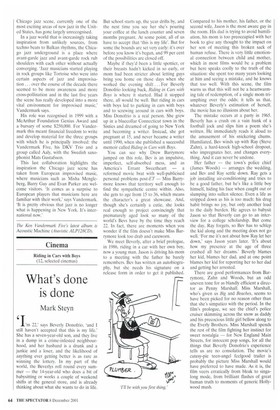Chicago calling
Stuart Nicholson
Is New York the jazz centre of the world? Well, lots of people still think so. Since the late 1920s it has been at the heart of jazz innovation — most of the significant styles of jazz were either developed or defined in its jazz clubs and after-hours joints. At one club, the Village Vanguard in Greenwich Village, key albums by pacesetting musicians such as John Coltrane and Bill Evans were recorded in the late 1950s and early 1960s, and it is still in business. Another club, Birdland. took the
name of the historic jazz club of the late 1940s-1950s named after Charlie Parker, while another, The Jazz Standard, has a name intended to resonate with jazz's past. History looms large, and on any given night you can take your pick from around 15 jazz venues and at least as many hole-in-thewall joints.
But scratch the surface and you will find little innovation, The music is mostly firmly centred on the jazz mainstream, and most of the better-known clubs, like the Blue Note, the Village Vanguard or the Iridium, charge prices only tourists can afford. Catering for the expectations of tourists has become an important consideration and perhaps explains why the New York jazz scene has become so conservative. No longer do you feel that it is the centre of the jazz world, despite the widely held belief among its opinion-shaping critics that if it is not happening here, then it's not happening anywhere'.
'Part of that is historical,' says the Chicago saxophonist, composer and bandleader Ken Vandermark. 'So much happened in New York that writers tend to focus on the city as a trend-setting place. Large record labels like Verve and Blue Note are based there, and they still think of New York as the centre of things. But it's not. New York is now just one of many places for jazz,' This failure to recognise developments in jazz outside New York has meant that the Chicago jazz scene, currently one of the most exciting areas of new jazz in the United States, has gone largely unrecognised.
In a jazz world that is increasingly taking inspiration from unlikely sources, from techno beats to Balkan rhythms, the Chicago jazz underground is a place where avant-garde jazz and avant-garde rock rub shoulders with each other without actually converging. 'Jazz musicians started playing in rock groups like Tortoise who were into certain aspects of jazz and improvisation ... over the course of the decade there seemed to be more awareness and more cross-pollination and in the last five years the scene has really developed into a more vital environment for improvised music,' Vandermark says.
His role was recognised in 1999 with a McArthur Foundation Genius Award and a bursary of some $250,000. For Vandermark this meant financial freedom to write and develop material for the three groups with which he is principally involved: the Vandermark Five, his DKV Trio and a group called Aaly, with the Swedish saxophonist Mats Gustafsson.
This last collaboration highlights the inspiration the Chicago jazz scene has taken from European improvised music, where musicians such as Misha Mengleberg, Barry Guy and Evan Parker are welcome visitors. 'It comes as a surprise to European players that musicians here are familiar with their work,' says Vandermark. 'It is pretty obvious that jazz is no longer what is happening in New York. It's international now.'























































































 Previous page
Previous page